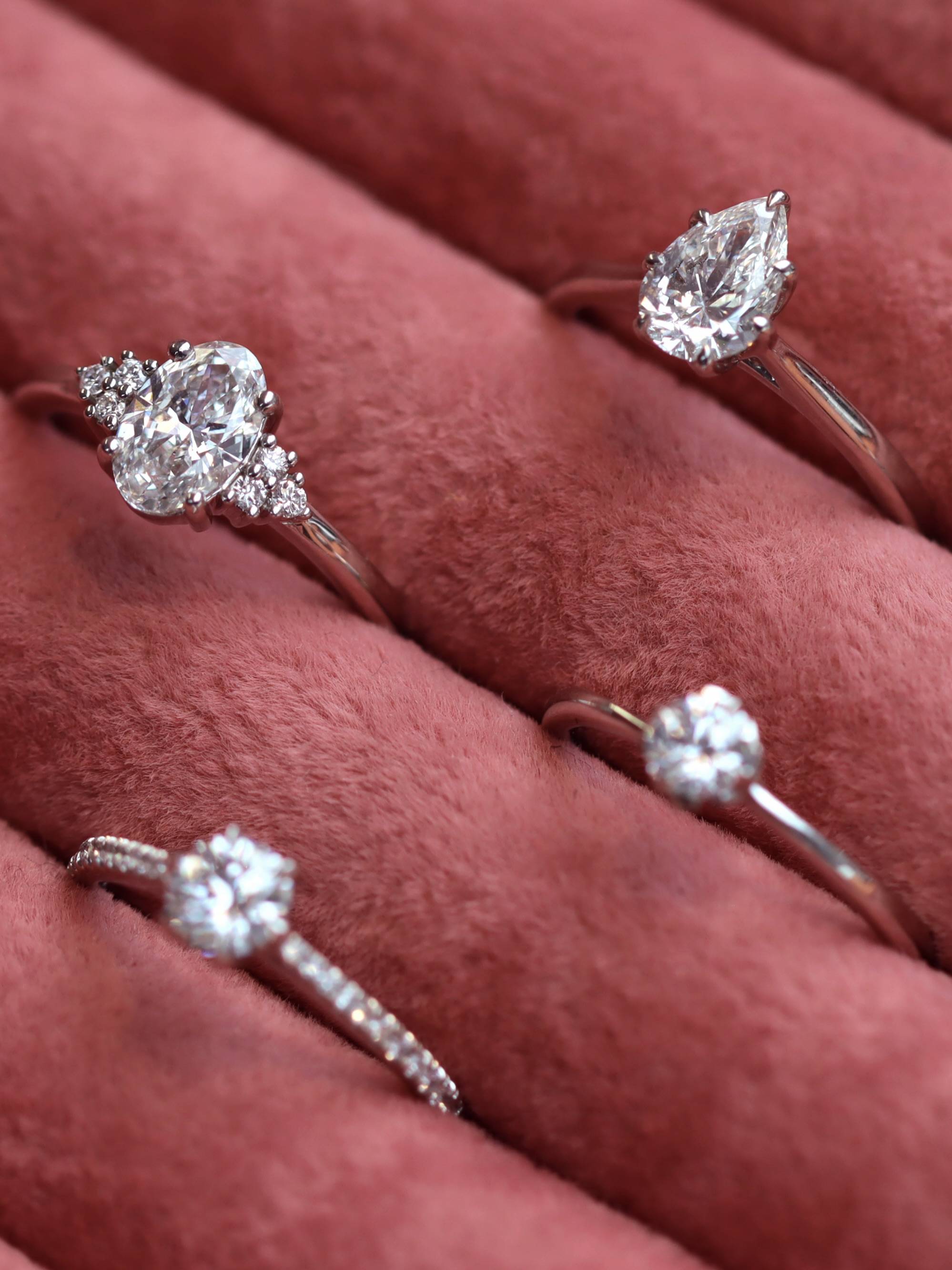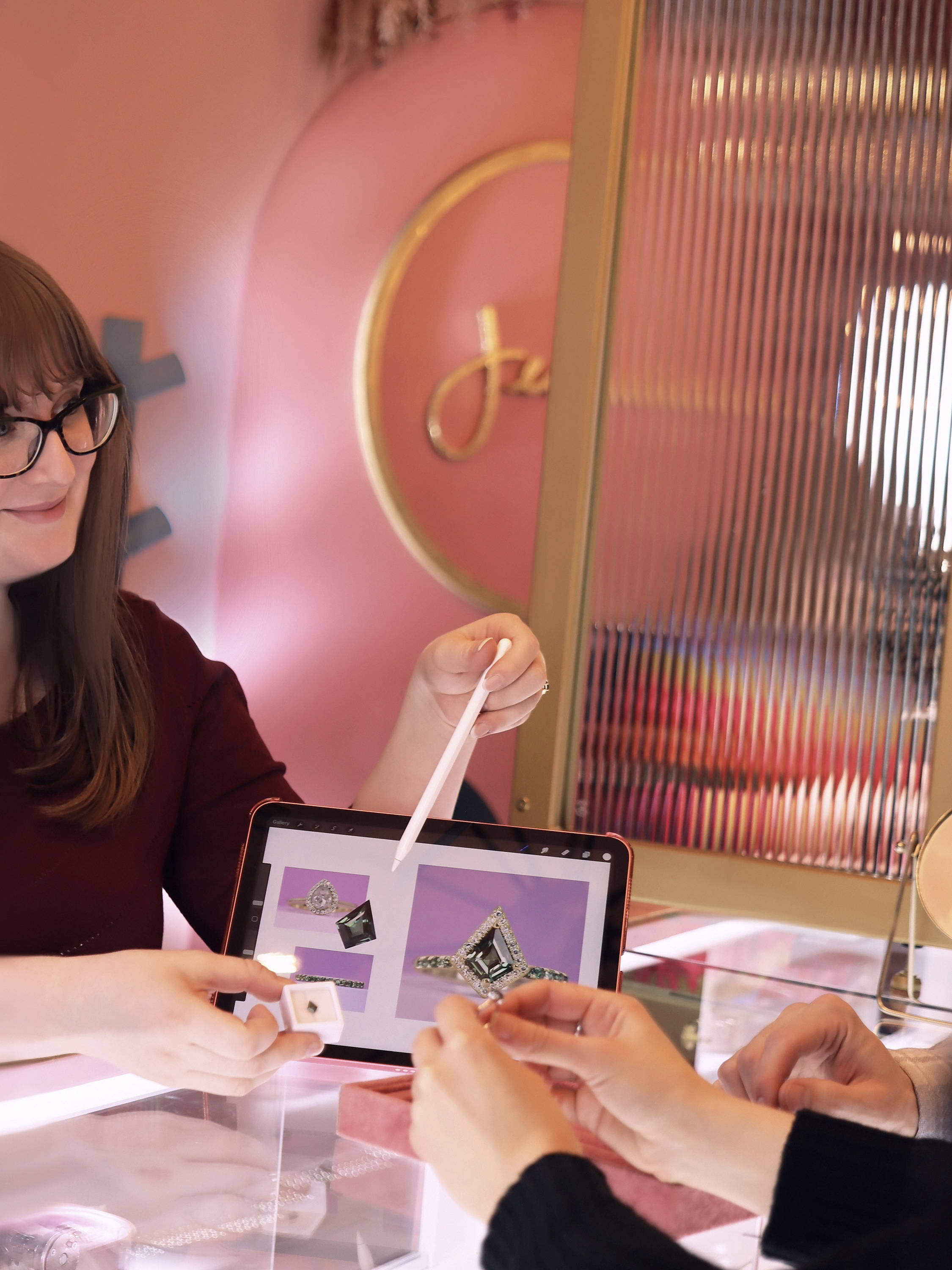GEMSTONE GUIDES
Natural Diamond Gemstone Guide
Natural diamonds are the number one most popular gemstone choice for engagement rings and wedding rings, and it's easy to see why! With their brilliant white sparkle and versatility, it's no surprise why these gemstones are the number one choice. Let’s take a look at what makes natural diamonds so special and find out why they are and will continue to be the world's favourite gemstone.
What is a diamond?
Diamonds are one of the most precious gemstones in the world and are the number one choice for engagement rings due to their extreme hardness and durability, as well as their beautiful appearance. Naturally, they form within the earth over millions of years and are mined all over the world. Most commonly white (or colourless) in colour, they are a versatile choice for jewellery as they exhibit a bright, captivating sparkle!
create your natural diamond piece with us
If you're looking to create a piece of jewellery with natural diamonds then take a look at our bespoke gallery or get in touch with one of our diamond experts who can collaborate with you to create your dream diamond piece.

diamond meaning
Diamonds have long been symbols of love and commitment and have been used in engagement and wedding rings for centuries. Due to their extreme hardness they are often thought to represent the unbreakable bond between spouses and the durability of a couple's everlasting love. They are also associated with qualities such as purity and perfection due to their bright white appearance and clarity. Diamonds are also the birthstone of April, so they hold a special place in the hearts of those born in the springtime month.
natural diamond hardness
Diamonds are famous for being super hard – like, really, really tough! Diamonds are in fact the hardest natural substance on Earth, so they are a great choice for engagement rings and other jewellery pieces that are worn daily. Interestingly, diamonds are also used in industrial tools like saws and drills and aren't exclusively limited to beautiful sparkly jewellery. Unsurprisingly, diamonds land at number 10 on the Mohs scale, meaning they rank the highest out of all gemstones.

LAB GROWN diamonds
Lab grown diamonds are simply diamonds which have been created in a laboratory. These laboratories recreate the natural conditions where diamonds grow, but they are sped up to be created in a matter of weeks or months as opposed to the millions of years it takes to form a natural diamond! Lab grown diamonds also provide peace of mind to those who are looking to be kinder to the planet as they are easily trackable, so you know where they have come from and can easily determine they are from a conflict free zone.
If you want to be super eco friendly, you can always opt for a solar powered lab grown diamond. These stones are made using wind and solar energy which is 100% renewable! Take a look at our Golden Hour collection to explore solar powered lab grown diamond engagement rings. If you would like to learn more about how lab grown diamonds are made then take a look at our dedicated guide.
Lab grown diamonds are chemically, physically and aesthetically identical to mined diamonds, the only difference is their formation process. They are also far less expensive than natural diamonds due to the fact that they can be produced at a higher rate than mined diamonds. So if you are looking for a larger diamond with better clarity and colour on a budget then a lab grown diamond engagement ring could be the one for you! Our full lab grown diamond guide tells you everything you need to know, and if you still have questions, we have a full section of our Jewellery School dedicated to these wonderful gemstones.
natural diamond value
The 4 Cs (cut, clarity, colour and carat weight) play an important part in assessing the value of a diamond. If a stone has excellent clarity, crystal clear colour, larger carat weight and is expertly cut, it will command a higher price. This is because these diamonds are harder to come by naturally, with many mined diamonds holding inclusions, having a tint of colour or are smaller in size.
Natural diamonds are among the most expensive gemstones in the world and many think of buying them as an investment, diamonds tend to hold their value long term so if you want a ring that will be valuable in the years to come then we recommend opting for a natural diamond.

natural diamond rarity
Overall, natural diamonds are not considered a rare stone, however, they are often found in small quantities and rarely hold the qualities desired for jewellery. When looking for a diamond with the right combination of the 4 Cs, this feat becomes even harder! That’s why larger, good quality diamonds can become extremely expensive.
Where are Diamonds Found
Natural white diamonds are found all over the world, with locations such as South Africa, Russia, Canada, Australia and some African countries such as Botswana and Angola being top diamond mining countries.
Diamonds come from deep within the earth's mantle, where they are formed over millions or even billions of years. Diamonds begin as carbon atoms and are subjected to extreme heat and pressure about 100 miles below the earth's surface. These extreme conditions cause the carbon atoms to bind together tightly which forms diamond crystals! These crystals then slowly move towards the surface when there’s geological events such as earthquakes or volcanic eruptions and once they are close enough to the earth’s surface they can be mined.
EARTH diamond Ring inspiration
Browse a selection of our natural diamond rings or contact the team if you can't see anything that catches your eye.

Natural diamond colours
Natural diamonds come in a rainbow of colours, from pinks and yellow to greens and even black! We have a full guide on coloured diamonds if you’d like to learn about all the bright and vibrant colours that diamonds come in.
In terms of white diamonds, these stones naturally form with variations in colour ranging from icy whites to faint hints of yellow or brown. The clearer (or whiter) the stone, the more expensive it will be. This is due to the fact that whiter diamonds refract light better, meaning they have a higher brilliance than those with duller colouring. Varying levels of inclusions can also form in diamonds which also affects the brilliance of the stone, so if you’re looking for a diamond with lots of sparkle then its best to opt for one with little to no inclusions.

Caring for diamond jewellery
Caring for your diamond jewellery ensures its longevity and brilliance. Here are five steps to maintain its beauty:
Regular Cleaning: Gently clean diamond jewellery with a soft-bristled brush (a baby toothbrush works fine) and mild soapy water to remove dirt and oils. Rinse thoroughly and pat dry with a soft cloth.
Avoid Chemicals: Keep diamonds away from harsh chemicals, such as chlorine and bleach, which can damage the metal settings and dull the gemstone's sparkle.
Safe Storage: Store diamond jewellery separately in a fabric-lined jewellery box or pouch to prevent scratches and tangling with other pieces.
Wear with Care: Remove diamond jewellery when engaging in activities like household chores or sports to prevent accidental damage or loss.
If you think your jewellery needs a refresh by a professional, book in for our repair and refresh service!
Where to buy diamond jewellery in the uk
While we primarily work with lab grown diamonds here at Jessica Flinn, we are always able to collaborate to ensure you leave us with your dream ring. We have the capability to ethically source and provide responsibly mined diamonds, thanks to our extensive training and partnerships with top suppliers. Our commitment lies in ensuring that every diamond we offer has been ethically and responsibly sourced, reflecting our dedication to ethical practices and providing you with the perfect piece of jewellery.
Read our Ethical Pledge to learn how we operate on an ethical level.
Book an Appointment
Our experts are here to help, whether you're looking to begin the bespoke process or just have a general enquiry. Don't hesitate to book an appointment, whether virtual or in person and get all your questions answered.








